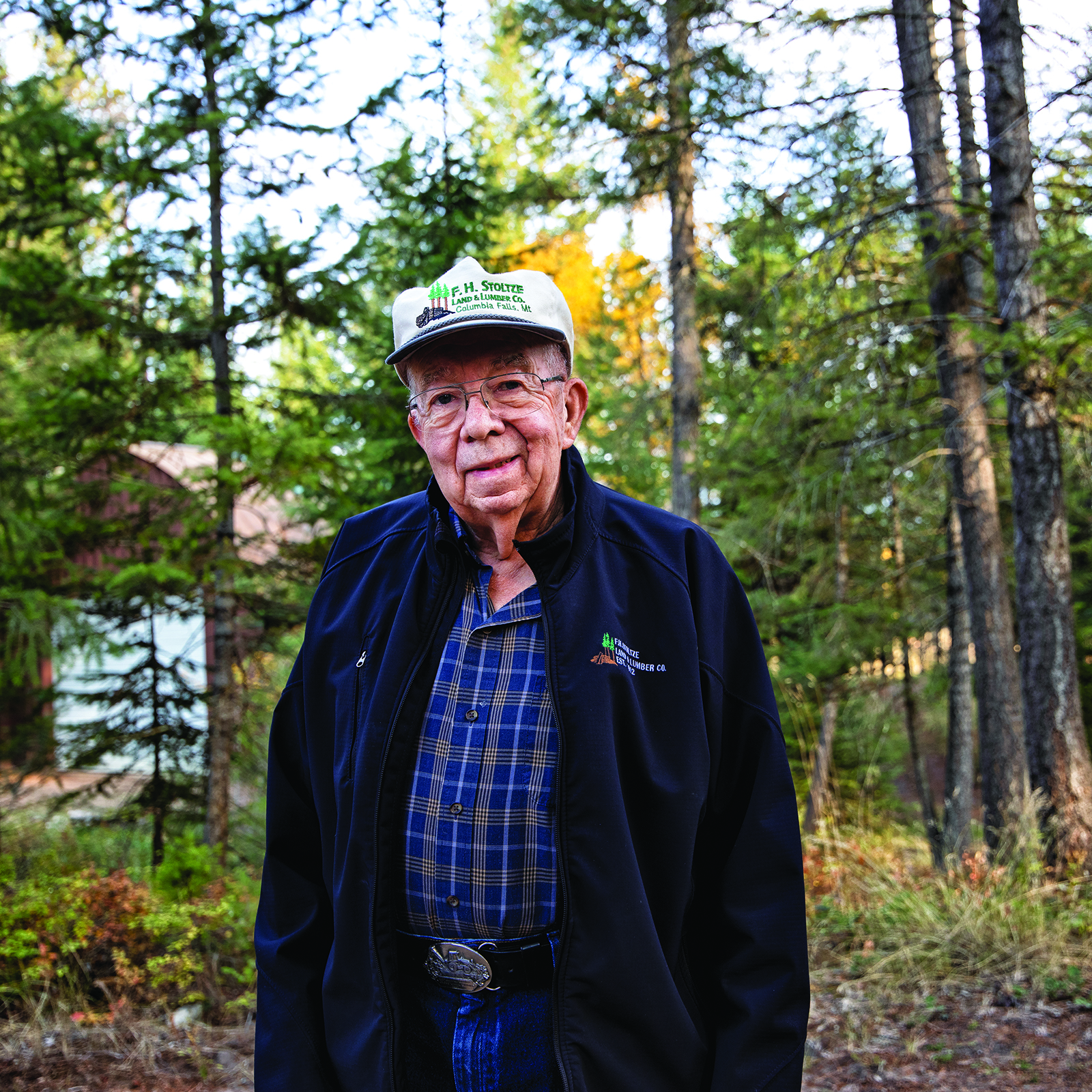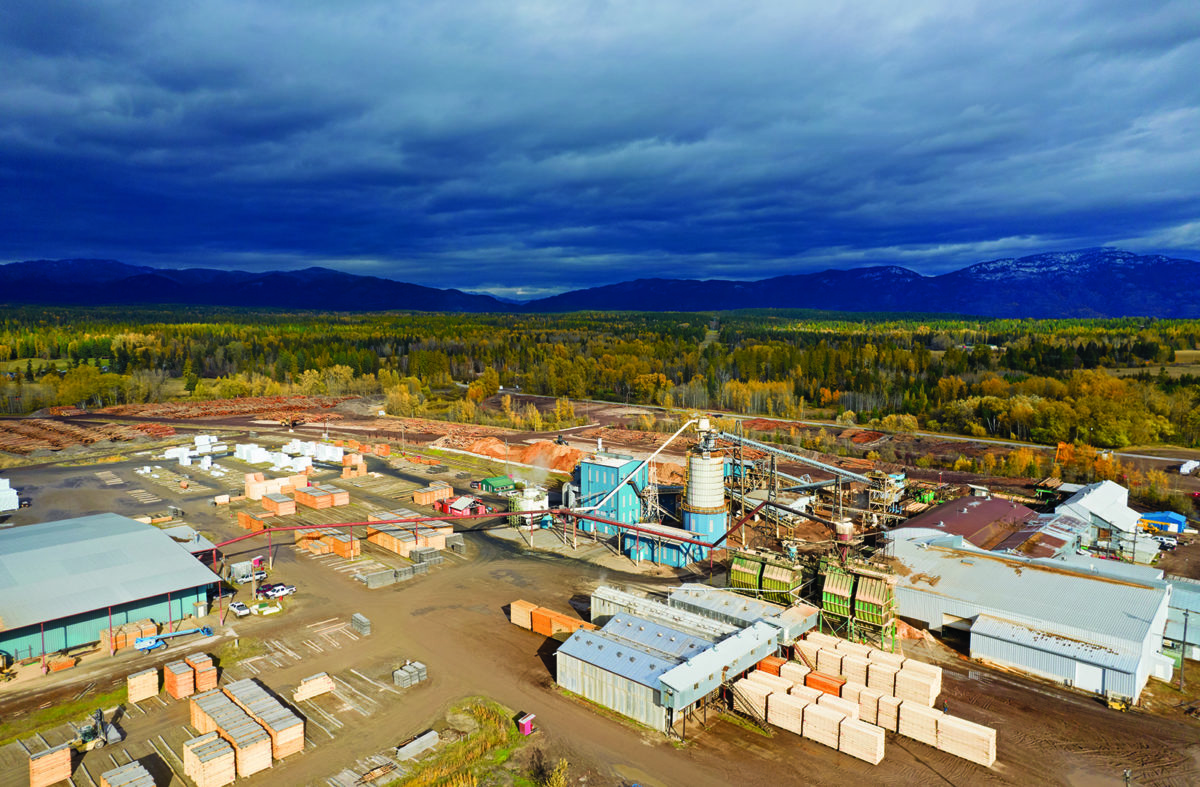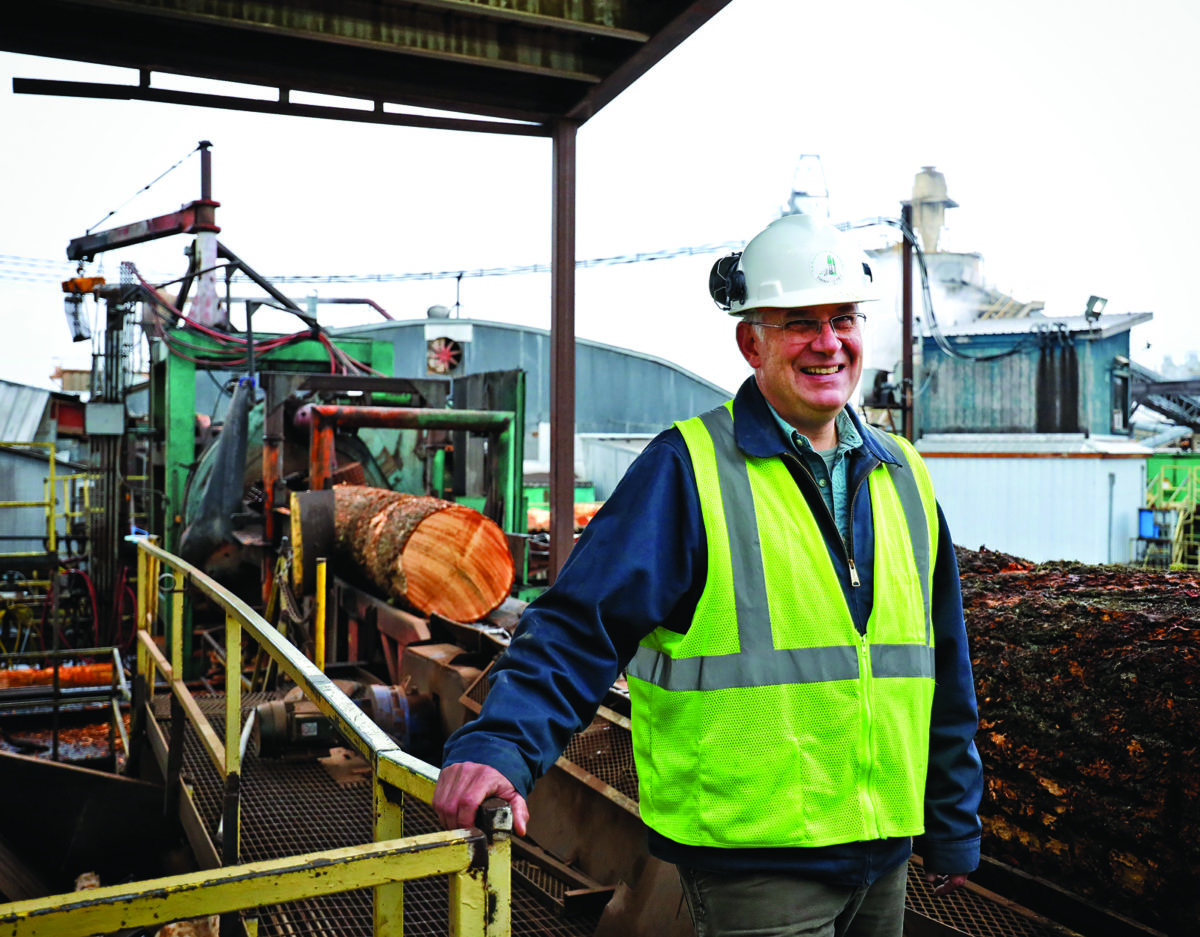
When Ron Buentemeier started working in the woods in the early 1960s, there were at least nine lumber mills running in the Flathead Valley. There was American Timber out in Olney, C&C Plywood in Evergreen, and Plum Creek in Columbia Falls, to name a few. And of course, there was F.H. Stoltze Land & Lumber Co., where Buentemeier was hired as a forester in 1962.
Six decades later, most of those mills have closed or have been sold, but F.H. Stoltze survives, turning logs into lumber at the same spot it has been for a century, at its mill off Half Moon Road west of Columbia Falls. In that time, the logging industry in western Montana and the broader Pacific Northwest has changed dramatically. The simple act of how loggers cut trees has changed, with automation playing a bigger role than ever in the mills. But perhaps the biggest change of all is the size of the industry. Today, F.H. Stoltze Land & Lumber Co. is one of only two sawmills remaining in the Flathead Valley and the oldest family-owned and operated private timber company in Montana.
The office above Ron Buentemeier’s shop is lined with artifacts from a long career with F.H. Stoltze. In the stairwell leading up to his office is a sign that declares, “This Family is Supported by Timber Dollars.” While Ron retired as the mill’s general manager and vice president more than a decade ago, he still spends a lot of time thinking about the place. In recent years, he’s spent a lot of his time researching the company’s history and its namesake.
“I worked 43 years there and I like to see Mr. Stoltze get the credit for what he did for this community,” Buentemeier said. “He helped build it.”

Stoltze the man was born on May 15, 1859. Buentemeier hasn’t been able to dig up too much on the man’s early years, but he knows that his father was a shoemaker in St. Paul, Minnesota. Stoltze was an industrious young man and in his 20s sold tools along the route of the Great Northern Railway, which was being built across Minnesota and North Dakota. It was out there on the plains that Stoltze made an interesting discovery: ground-up bison bones made good fertilizer. According to Buentemeier, Stoltze would ship between 400 and 500 freight carloads of bones east to market between 1885 and 1886. This made Stoltze a big customer on the new railroad and it caught the attention of the railroad’s owner, James J. Hill. The railroad man was apparently impressed by the young man’s entrepreneurial spirit and made him a unique offer to build towns along the Great Northern.
“Obviously, if you’re building a railroad, you want people along that railroad to actually use it,” Buentemeier said.
Stoltze spent the next decade building towns in North Dakota, along with all the establishments needed to help a community flourish, like lumber yards and general stores.
Shortly after the turn of the century, Stoltze arrived in Northwest Montana. There was no need for town building here, at least not from scratch, as the Flathead Valley was already booming. So Stoltze got into the sawmill business. In 1909, he teamed up with two others to construct a new mill on the shores of Smith Lake west of Kalispell, replacing one that had burned the year before (mills are full of flammable material and Buentemeier said fires were and are common, even today. By one count, at least 22 mills caught fire in North America in 2019 and 28 burned the following year, although the extent of damage varied from incident to incident).
In 1912, Stoltze formed a new company for his ventures, specifically to manage his timberlands, called F.H. Stoltze Land (“and Lumber” would be added later). Over the next few years, Stoltze opened and operated additional mills in the area. While Stoltze’s mills were fruitful, they had one major flaw: They were all far from the railroad that could easily move his product to market. To correct that deficiency, Stoltze and his partners went searching for a new site, settling on a plot of land south of the railroad tracks at a spot called Half Moon, just west of Columbia Falls. A small mill had operated there in the past, but Stoltze and his partners had bigger plans. Using pieces from other mills, they built a brand new lumbermill over the course of five years. The new mill began sawing logs and producing lumber in May 1923.

A century later, they’re still sawing logs out at Half Moon. As of 2022, the company has about 105 employees producing 66.5 million board feet of lumber annually. But lumber isn’t the only product they’re producing now, said Paul McKenzie, vice president and general manager of the mill since 2021. Aside from lumber, they’re also turning “residues,” things like sawdust and chips, into something of value. In decades past, those byproducts would simply be burned, but now they’re being sold to other companies to make products like fiberboard. McKenzie said Stoltze is even selling to its old crosstown rival, Weyerhaeuser, which merged with Plum Creek Timber back in 2016. McKenzie said that the timber industry has shrunk in recent decades to a point where it’s important for companies, even old rivals, to work together to get as much as they can out of their products.
“We want to get as much value as possible out of our trees because trees grow slowly here in western Montana,” he said.
Because of the long winters and short growing seasons, it can take 70 to 90 years to grow a tree in western Montana. But just a few hundred miles west, in the Cascade Mountains of western Washington and Oregon, it can take about 40 years. It’s even faster in the Southeast, with some trees growing to maturity in just 20 or 30 years. But McKenzie likes to point out that slow and steady still wins the race, and while it might take longer to grow, the timber in western Montana is of a higher quality because it has tighter tree rings and is thus stronger than what you’ll find elsewhere.
The company has even established a new branch of the business called Stoltze Timber Systems, which produces pre-fabricated timber structures using cross-laminated timber. The wood structures are easier to erect than traditional construction methods and help the company use smaller logs.
About 5% of the logs processed at Half Moon come from Stoltze-owned timberland. The company owns 39,000 acres in Flathead and Lincoln counties. The rest comes from federal, state and privately owned land. The federal government is the biggest landowner in Northwest Montana, but the amount of timber that has come from the national forests has fluctuated greatly in recent decades as timber companies and land managers have gotten into heated legal battles with environmental groups about cutting. However, in 2021, the company got 53% of its logs from land managed by the U.S. Forest Service, the most since the 1990s. McKenzie said that more logs could come from Stoltze’s own land, but that it’s important to the company to not overcut. F.H. Stoltze follows nationally recognized sustainability standards and is proud of that. Those standards require the company to plant trees when it cuts and to protect water, wildlife and other ecosystems.
“We manage based on what the forests need,” McKenzie said. “And we think our lands are a showcase of how good sustainable forest management can work.”
McKenzie said he believed the public’s opinion of forest management has changed in recent years, due in large part to the ever-growing danger of wildfires in the west. Forests that are managed or have had fire play its natural role on the landscape tend not to burn as intensely.
“Wildfires are making people realize that forests do change over time, whether we want them to change or not, but that good forest management can help guide those changes,” he said.
A big part of F.H. Stoltze’s land management philosophy has been to allow the public access to its property. Perhaps one of the most well-known pieces of company-owned land is Haskill Basin just east of Whitefish. That section of land was protected from future development in 2016 when a conservation easement created permanent protections on 3,020 acres, which also happens to hold most of the City of Whitefish’s drinking water. The easement means homes will not be built on the land, recreational access will remain and it will still be managed as a timber-producing forest in the future.
But maintaining public access isn’t always easy, McKenzie said. As more and more people recreate in the forest, McKenzie has grappled with more emergent problems, especially with people creating new trails. Although, he’s quick to add that “90% of users are good, it’s the 10% that are challenging.”
Public land access and conservation easements aren’t the only initiatives where the company has worked with the local community. In the early 2010s, the company was looking for a new steam boiler to power its mill. As part of that, it also constructed a new biomass-fueled electric generation facility at the Half Moon plant. That facility produces electricity, about 2.5 megawatts every month, that is then sold to Flathead Electric Cooperative. Jason Williams, assistant general manager of Flathead Electric, said they have a 20-year deal to buy the locally produced electricity from Stoltze.
“We have a really great working relationship with F.H. Stoltze and all of that power is used right here locally,” Williams said.

The last 25 years have been challenging for the timber industry and countless mills across western Montana and the Northwest have closed. But McKenzie said he’s optimistic about the future of his company, especially as the need for more housing here and across the country emerges.
“The industry has gotten to a point where it really can’t shrink anymore,” he said. “Now we need to grow.”
Perhaps the biggest challenge facing the company is one that’s challenging a lot of businesses right now — a lack of workers. McKenzie said that for years it seemed as if parents discouraged their children from getting jobs in the woods because it was dangerous or that there were better opportunities elsewhere. But McKenzie said that characterization is unfair and that there are many well-paying and highly technical jobs to be had at a place like F.H. Stotze. In 2021, the company’s local payroll, including benefits, exceeded $11.1 million.
Buentemeier echoed the sentiment that F.H. Stoltze was a good place to work and one that has taken care of its employees throughout its history. Back in the early 1930s, when the Great Depression shuttered the mill for a few years, the company store remained open and maintained a very lenient credit policy so families could get by. In the 1980s, when the timber industry was in a spiral and most mills were laying people off, Buentemeier said the Stoltze family kept their mill running and their workers on the payroll.
“I don’t think you’d find many places that would do that today,” Buentemeier said. “They’ve always been a good company to work for and they’ve always treated their men right.”
Sitting in his office not far from the mill that has been churning out lumber for nearly a century, McKenzie said it’s impressive to think about all the changes that have happened to the industry in that time. Even since he arrived in 2003, automation now plays a much bigger role in the process of cutting logs and lumber. But even with those changes, the company can provide good-paying jobs to local residents. Being able to embrace those advancements and adapt to a shifting environmental and social landscape will be key to the next century at the mill, McKenzie said.
“We’ve been through tough times in the past, but we’re a survivor,” McKenzie said. “And you can’t keep doing the same thing you’ve done for 100 years and expect to still be around in another 100 years. You have to innovate.”